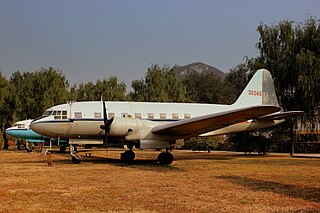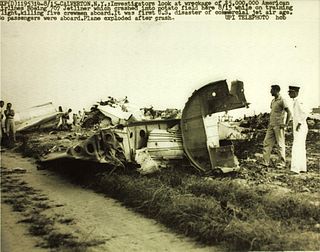
Scandinavian Airlines System Flight 933 was a scheduled international flight from Denmark to the United States that on January 13, 1969, crashed into Santa Monica Bay at 19:21, approximately 6 nautical miles (11 km) west of Los Angeles International Airport (LAX) in California, United States. The crash into the sea was caused by pilot error during approach to runway 07R; the pilots were so occupied with the nose gear light not turning green that they lost awareness of the situation and failed to keep track of their altitude. The Scandinavian Airlines System (SAS) aircraft had a crew of nine and 36 passengers, of whom 15 died in the accident. The flight originated at Copenhagen Airport, Denmark, and had a stopover at Seattle–Tacoma International Airport, where there was a change of crew. The crash was similar to Eastern Air Lines Flight 401. The crash site was in international waters, but the National Transportation Safety Board carried out an investigation, which was published on July 1, 1970. The report stated the probable cause as improper crew resource management and stated that the aircraft was fully capable of carrying out the approach and landing. The aircraft was conducting an instrument approach, but was following an unauthorized back course approach.

The Ilyushin Il-12 is a Soviet twin-engine cargo aircraft, developed in the mid-1940s for small and medium-haul airline routes and as a military transport.

Aeroflot Flight 99 was a Tupolev Tu-124 operating a scheduled domestic passenger flight from Leningrad to Murmansk, both in the Soviet Union, which crashed while attempting to land on 11 November 1965. Of the 64 passengers and crew on board, 32 were killed in the accident, and many of the survivors sustained injuries.

American Airlines Flight 514 was a training flight from Idlewild International Airport, to the Grumman Aircraft Corp. airfield. On the afternoon of August 15, 1959, the Boeing 707 operating the flight crashed near the Calverton airport, killing all five crew members aboard. This was the first accident to involve a Boeing 707, which had only gone into service in October of the previous year, and the first of three accidents involving American's 707s in the New York area within three years, followed by Flight 1502 and Flight 1.

True Aviation Flight 21 was a regularly scheduled domestic cargo flight in Bangladesh, flying from Cox's Bazar to Jashore. On 9 March 2016, the Antonov An-26 crashed into the Bay of Bengal shortly after take-off from Cox's Bazar Airport. The aircraft was attempting to return to the airport after experiencing an engine failure. Three of the four crew members on board were killed in the accident.

Aeroflot Flight 5003 was a scheduled passenger flight from Tashkent to Mineralnye Vody with a stopover in Nukus; the Ilyushin 18V operating the route on 15 February 1977 crashed near the district of Mineralnye Vody while climbing after a missed approach. Of the 98 people on board, 77 perished in the crash.

Aeroflot Flight 558 was a scheduled Ilyushin Il-18V domestic passenger flight from Karaganda to Moscow that crashed into a field in the Abzelilovsky District on 31 August 1972 as a result of a fire stemming from exploded passenger baggage, killing all 102 people on board.

Aeroflot Flight 101/X-20 was a scheduled domestic passenger flight from Moscow to Alma-Ata via Omsk, Soviet Union, that crashed in low visibility conditions on 4 January 1965, killing 64 of the 103 people on board.

Aeroflot Flight L-51 was a scheduled domestic passenger flight operated by an Antonov An-24 that crashed on approach to Liepāja International Airport on 30 December 1967, resulting in the death of 43 of the 51 people on board. To date, it is the deadliest aviation accident in Latvian history. The investigation revealed the cause of the accident to be pilot error.

Aeroflot Flight 207 was a Soviet domestic passenger flight from Rostov-on-Don Airport to Tbilisi International Airport that crashed on 10 June 1960 in the Tkvarcheli district. The crash involved an Ilyushin Il-14 aircraft operated by Aeroflot. There were 24 passengers and 7 crew on board, all of whom perished in the crash.

The 1951 Novosibirsk Il-12 crash was an aviation disaster involving an Ilyushin Il-12P aircraft operated by Aeroflot on 17 November 1951, which resulted in the deaths of 23 people.

The Yak-40 crash near Batumi was an aviation accident that occurred on 15 July 1975 in the mountains near Batumi involving a Yak-40 aircraft operated by Aeroflot, resulting in the deaths of 40 people.

Aeroflot Flight F-28 was a domestic flight from Talas to Frunze that crashed on Saturday, June 28, 1969, in the mountains of the Kyrgyz Range near Talas, resulting in the deaths of 40 people.

Aeroflot Flight F-77 was an An-24B operating from Moscow to Bugulma with an intermediate stop in Cheboksary that crashed near Bugulma on 2 March 1986, resulting in the deaths of all 38 occupants on board.

The 1953 Kemerovo mid-air collision was an aviation accident where two Li-2 aircraft collided over Kemerovo Oblast, Soviet Union, on May 27, 1953, resulting in the deaths of all 27 people aboard both aircraft.

Aeroflot Flight 37577 was a scheduled domestic flight from Perm to Sovetsky. On November 21, 1989, the An-24B aircraft crashed near Sovetsky, killing 32 of the 40 people on board.

Aeroflot Flight 6246 was an aviation accident that occurred on Saturday, January 13, 1990, 3 kilometers from Pervouralsk, during a forced landing on a snow-covered field of a Tu-134A airliner operated by Aeroflot. The flight was a domestic route from Tyumen to Ufa to Volgograd. Of the 71 people on board, 27 lost their lives.

Aeroflot Flight 105 was an aviation accident involving an Ilyushin Il-12P aircraft operated by Aeroflot, which occurred on June 9, 1958 near Magadan, resulting in the deaths of 24 people.

The 1961 Mineralnye Vody Il-18 crash was an aviation accident that occurred on December 31, 1961, near the city of Mineralnye Vody. The accident involved an Ilyushin Il-18V aircraft operated by Aeroflot and resulted in the deaths of 32 people.

Aeroflot Flight 205 was a crash involving an Aeroflot passenger aircraft Il-14P that occurred on 18 January 1959, near Stalingrad. The crash resulted in the deaths of all 25 people on board.


















